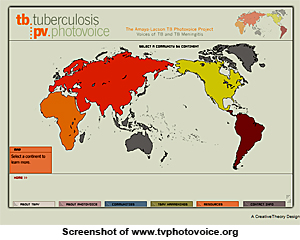


|
|
|
|
|
|
|
|
|
|
|
|
||||||||||||||
|
||||||||||||||
|
|
||||||||||||||
|
||||||||||||||
|
Physician’s death to TB gives voice, face Posted 03/15/2007
The top edge is worn, but the wide, bright smile of a young woman with big dark eyes is timeless. She’s seated in a café in Granada, Spain, in front of a slice of birthday cake with pink frosting and a single candle. The woman is Lacson’s wife, a physician with a master’s degree in public health, who appears to be the picture of beauty, health and optimism. Yet in 2004, at age 38, two years after the photo was taken, Dr. Claudia Amaya-Lacson died from tuberculosis, an infectious disease that many people mistakenly believe has been eradicated. “More than anything, Claudia wanted to be a mother,” said Lacson, whose own dark eyes still carry the sadness of the loss of his wife. “2004 started out incredibly. She became pregnant, and we learned that we were having twins. TB didn’t seem to be something that would affect us.” Lacson has turned his despair into a mission to share Claudia’s battle against the deadly disease, and he’s doing it via photographs taken by people with TB. Through the Amaya-Lacson TB Photovoice Project at the University of South Carolina’s Arnold School of Public Health, Lacson is working with people around the world to use photographs to put a face on TB and to give a voice to patients’ stories. Dr. Donna Richter, dean of the Arnold School, said the TB Photovoice Project is a good example of what the school is doing to fulfill its mission to bring attention to a national and international public health problem. "Tuberculosis remains a significant public health threat in many parts of the world, and the toll it takes on individuals, families and communities can be significant,” Ricther said. “The Amaya-Lacson TB Photovoice Project is an innovative approach to providing a powerful voice to individuals and their families regarding this disease, while assisting local communities in developing strategies to disseminate knowledge and raise awareness." The couple’s story begins in 1994 at the Arnold School, where both were beginning their studies for master’s degrees in public health. Amaya had earned her medical degree in Bogata, Colombia, and had come to Carolina for a master’s degree in public health. Lacson, whose mother is a physician, had earned a bachelor’s degree in music education from the University of South Carolina and served two years in the Peace Corps in Ecuador. He returned to the Palmetto State prepare for a career in public health. The couple married in 1996 and left South Carolina three years later for promising careers in Atlanta: she to the Georgia Health Policy Center at Georgia State University for a job with a rural health program; he to the Centers for Disease Control and Prevention. In 2004, the Lacsons learned that they were about to become parents. It was their dream. “Then, Claudia began having symptoms that she couldn’t figure out,” said Lacson, pointing out that no one thought she had TB because the signs of her illness were not pulmonary. Diagnosed with TB meningitis, a rare form of tuberculosis, Amaya-Lacson was given a 50-percent chance of survival by doctors at Emory Crawford Long Hospital. But the drugs available for her disease weren’t effective in treating her case. On May 22, Amaya-Lacson gave birth to a daughter, Emma, who died. Soon afterward the mother suffered a series of devastating strokes. On July 31, Amaya-Lacson died. DEATH HARD TO UNDERSTAND “We thought this couldn’t happen to us,” Lacson said. “We were in a medical-health community. TB seemed like something you’d find in another country. Not the United States.” Amaya-Lacson probably contracted the disease while working in a TB clinic in South America. The disease may have been dormant until her immunity system changed with her pregnancy, said Lacson, who left the CDC about six months after his wife’s death and returned to South Carolina. Although he has many unanswered questions and unfulfilled dreams, he is clear in his purpose. Lacson wants the public, healthcare professionals and policymakers to understand that “we have to talk about TB” and that new drugs are needed to treat the disease. Lacson said about one-third of the people in the world are infected with TB, but they don’t know it because the disease is dormant. In the TB Photovoice Project at the University of South Carolina, founded by Lacson, TB patients are asked to join a group, much like a support group. They are given cameras and are asked to photograph the people, events and places in their lives that are important to them. They meet regularly with a project leader, show their photographs and discuss the pictures’ meanings. The project is under way in Thailand, Brazil and El Paso, Texas. TB patients in the rural Pee Dee region of South Carolina also are being recruited for the Photovoice Project. “It is time for us to create a mobilized community among people with TB, policymakers and the healthcare professionals who provide treatment,” Lacson said. “We have to advocate for better drugs, better services and TB prevention.” |
| Columbia, SC 29208 • 803-777-7000 • sphweb@gwm.sc.edu | © University of South Carolina Board of Trustees |
 Romel
Lacson takes a small color photo from his wallet and lays it on a table.
Romel
Lacson takes a small color photo from his wallet and lays it on a table.